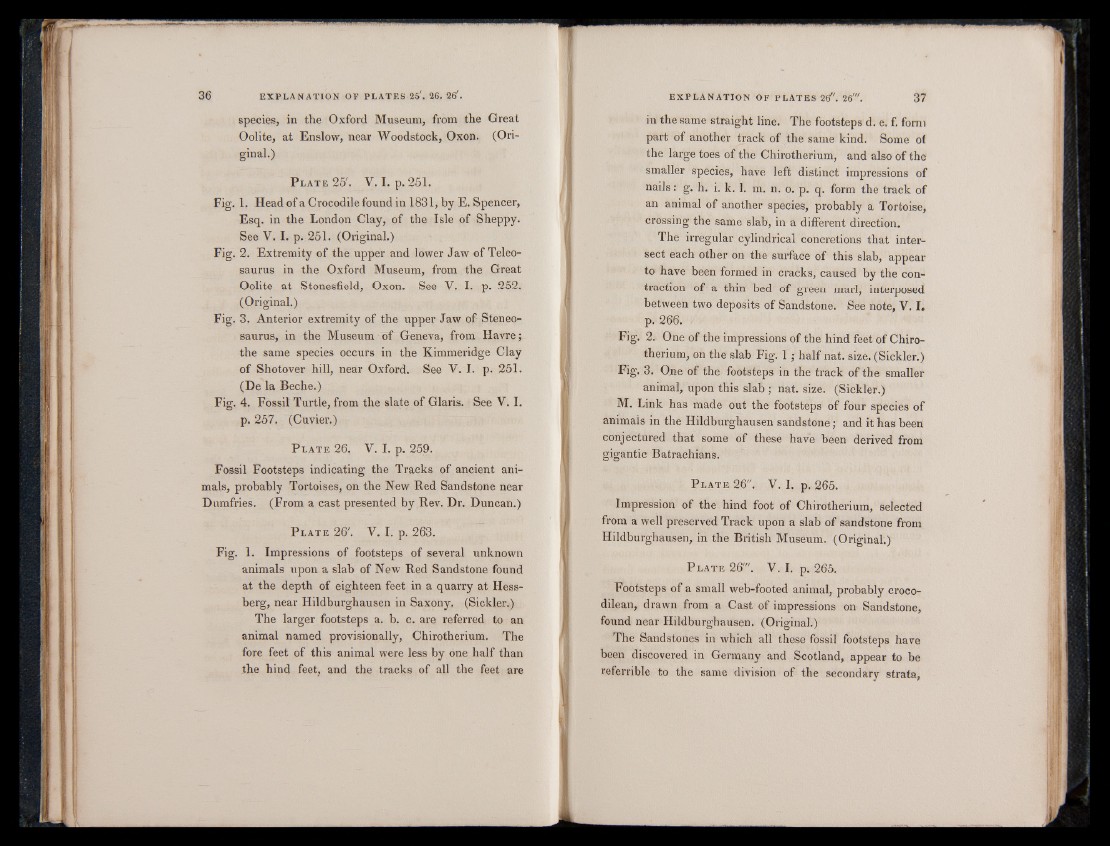
species, in the Oxford Museum, from the Great
Oolite, at Enslow, near Woodstock, Oxon. (Original.)
P late 25'. V. I. p. 251.
Fig. 1. Head of a Crocodile found in 1831, by E. Spencer,
Esq. in the London Clay, of the Isle of Sheppy.
See V. I. p. 251. (Original.)
Fig. 2. Extremity of the upper and lower Jaw of Teleo-
saurus in the Oxford Museum, from the Great
Oolite at Stonesfield, Oxon. See V, I. p. 252,
(Original.)
Fig. 3. Anterior extremity of the upper Jaw of Steneo-
saurus, in the Museum of Geneva, from Havre;
the same species occurs in the Kimmeridge Clay
of Shotover hill, near Oxford. See V. I. p. 251.
(De la Beche.)
Fig. 4. Fossil Turtle, from the slate of Glaris. See V. I.
p. 257. (Cuvier.)
P late 26, V. I. p. 259.
Fossil Footsteps indicating the Tracks of ancient animals,
probably Tortoises, on the New Red Sandstone near
Dumfries. (From a cast presented by Rev. Dr. Duncan.)
P late 26'. V. I. p. 263.
Fig. 1. Impressions of footsteps of several unknown
animals upon a slab of New Red Sandstone found
at the depth of eighteen feet in a quarry at Hess-
berg, near Hildburghausen in Saxony. (Sickler.)
The larger footsteps a. b. c. are referred to an
animal named provisionally, Chirotherium. The
fore feet of this animal were less by one half than
the hind feet, and the tracks of all the feet are
in the same straight line. The footsteps d. e. f. form
part of another track of the same kind. Some of
the large toes of the Chirotherium, and also of the
smaller species, have left distinct impressions of
nails: g. h. i. k. 1. m. n. o. p. q. form the track of
an animal of another species, probably a Tortoise,
crossing the same slab, in a different direction.
The irregular cylindrical concretions that intersect
each other on the surface of this slab, appear
to have been formed in cracks, caused by the contraction
of a thin bed of green marl, interposed
between two deposits of Sandstone. See note, V. I.
p. 266.
Fig. 2. One of the impressions of the hind feet of Chirotherium,
on the slab Fig. 1 ; half nat. size. (Sickler.)
Fig. 3. One of the footsteps in the track of the smaller
animal, upon this slab ; nat. size. (Sickler.)
M. Link has made out the footsteps of four species of
animals in the Hildburghausen sandstone; and it has been
conjectured that some of these have been derived from
gigantic Batrachians.
P late 26", V. I. p. 265.
Impression of the hind foot of Chirotherium, selected
from a well preserved Track upon a slab of sandstone from
Hildburghausen, in the British Museum. (Original.)
P late 26'". V. I. p. 265.
Footsteps of a small web-footed animal, probably croco-
dilean, drawn from a Cast of impressions on Sandstone,
found near Hildburghausen. (Original.)
The Sandstones in which all these fossil footsteps have
been discovered in Germany and Scotland, appear to be
referrible to the same division of the secondary strata,